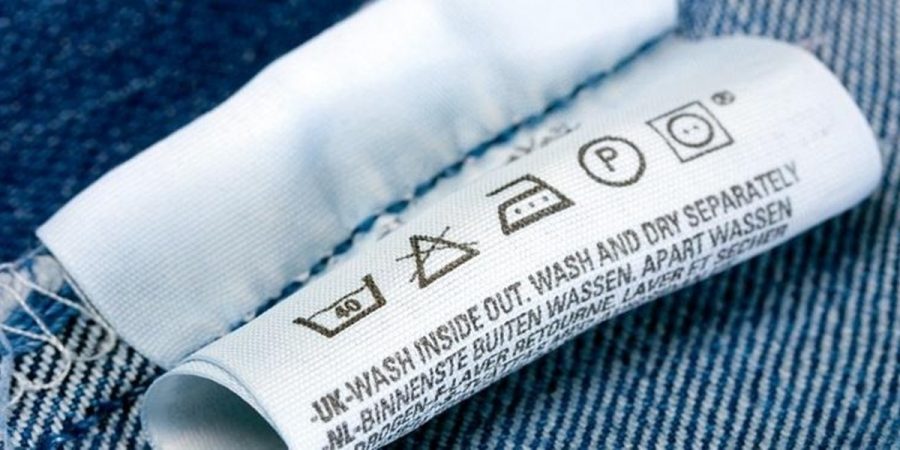The modern laundry care label we see today is the evolution of an extensive classification and regulation system known as the ‘Textile and Wool Act’ put in place by the US Federal Trade Commission in 1939. Contrary to popular belief, these labels do not actually tell you the best way to clean an item of clothing. Instead, laundry care symbols and tags are there to advise you how not to destroy your clothing. That’s as much for the consumer as it is for the manufacturer, protecting the latter from defective materials claims. In essence, they’re advising the range of what you can and can’t do to an item. Beyond that, it’s on you.
In many estates, the laundress is handling some of the most fragile and irreplaceable items in the house. One of one couture gowns and suits made by hand on Savile Row require expert care. The skilled laundress knows not only how to interpret laundry care symbols, but has an extensive repertoire of textile reactions to liquids, heat, steam, chemicals, and common care methods.
Household Management blogger Taylor Flanery offers her tips on deciphering care labels:
Tip About Warning Words On Laundry Tags
Beware of words like “only,” “no,” and “do not,” because if these words are on a laundry label they generally need to be taken seriously.
When the term “only” is used regarding dry cleaning, do not pass go, do not collect $200, go directly to the dry cleaner.
If, on the other hand, the word “only” is absent, you can take the chance and risk it. You will need to look not only at the main fabric, but all linings and embellishments to see if each part can be washed either in the washing machine and/or by hand.
Only if the most delicate parts of the garment can stand washing in water (and each part is colorfast) should the garment go anywhere near water.
Further, when a laundry label says “hand wash,” this means it should not go in the washing machine, even in the delicate cycle.
I have found I can put most of these items in the washing machine in the delicate cycle anyway even when it says not to, unless it says “only,” but I know I am taking a risk.
An important rule for anytime you are considering ignoring laundry symbols or laundry labels:
Do not do anything besides follow the instructions meticulously if you cannot bear the thought of ruining the item.
Temperature For Washing And Drying
When the tag does not mention a water temperature that it should be washed in, then it can be washed in whatever temperature you like. (I prefer hot, because it tends to get the clothes the cleanest.)
However, if a temperature for the water is listed you have been put on notice that a higher temperature may (but not necessarily always) be bad for that item.
The same rule applies with the dryer — no mention of a temperature means that it can be dried on the hottest setting if you wish.
Otherwise, if a temperature is mentioned, you have been put on notice that a higher temperature may harm the item.
Tip About Silence In Laundry Tags:
Silence, or not mentioning an issue, typically means that you can do whatever you want in regard to that issue, such as any type of bleach, any type of water temperature, and any drying method.
When you see the instruction, “machine wash, tumble dry,” this means you can use any temperature for washing, any temperature for drying, and can also use any type of bleach you want, and it does not need to be ironed.
Clothes with these instructions in the laundry label means it is one of the best types of play clothes to get for kids, because kids can be rough on clothes, and this means you can be rough back to get them clean.
Pay Attention When The Laundry Tag Says “Wash With Like Colors” Or “Wash Separately”
When a laundry tag says “wash separately” or “wash with like colors” I generally try not to even buy it (I will make an exception, sometimes, if it says it must be washed separately only for the first few loads).
This language means that the dye in the fabric is not color fast and will bleed onto anything else washed with it.
Families with small children do not have time to be doing lots of little separate loads of laundry for one or two items at a time. Therefore, these types of warnings make me run the other way.
Meaning Of Laundry Symbols Regarding Bleach
Any household with children needs both chlorine bleach and color bleach in their laundry supplies.
Most people know that chlorine bleach cannot be used on colors, at least not consistently.
In addition, there are some colored fabrics where just one wash with chlorine bleach will ruin them.
Therefore, if you need or want to use chlorine bleach on any colored fabrics it is important to look at the laundry symbols first to understand the amount of risk you are incurring.
The care instructions regarding color bleach, also known as nonchlorine bleach or oxygen bleach, are far less clear than they should be.
Because of FTC regulation manufacturers cannot just say you can use nonchlorine bleach on an item. They have to say, “only nonchlorine bleach when needed.”
The “when needed” part of the laundry tag seems to imply that using color bleach every load would be bad, but that it can be used occasionally.
Ironically, color bleach cannot change dingy clothes back into bright ones. Instead, the power of color bleach is that it can keep bright clothes staying that way and prevent dinginess, but only if used consistently.
In general, if a fabric is safe for color bleach sometimes, it is safe for it to be used consistently on the garment, despite the “as needed” portion of the instruction that implies otherwise.
If a laundry symbol indicates “no bleach,” neither chlorine bleach nor color bleach can be used on the article, at least regularly.
Ironing Instructions On Laundry Tags
If no mention is made of ironing on the laundry labels that means you do not need to iron the garment, but if you wanted to that would be OK.
I personally hate to iron, and try to do it as infrequently as possible, so I take my clothes out of the dryer promptly or follow these steps to reduce wrinkles if I forgot to get them out when the dryer stopped.
If a care label says it must be ironed it seriously will need to be ironed — like it will be a wad of fabric when it comes out of the dryer.
Because manufacturers know people, in general, do not like to iron they try to avoid mentioning that something needs to be ironed regularly unless it really has to be.
Therefore, don’t be surprised if some clothing that does not mention ironing at all in the care instructions looks pretty wrinkly coming out of the dryer and could use a good pass with the iron.
I generally run away from clothes in the store if they say they will need to be ironed because I know I won’t do it often, and will basically be wasting my money if I buy it.
Further, if a tag says “do not iron,” believe it. Do not even touch it with an iron for a minor touch up. You will most likely be sorry.
Conclusion
I hope this article helped explain what laundry symbols mean and also gave you some loose guidelines to follow for when you can and cannot ignore them.
There are never any hard and fast rules, but the more laundry you do the more you will get a feel for what will and will not work when bending the rules.
Read more of Taylor’s Blog “Household Management 101”, and look into the other resources:
The Laundress Blog has a great printable guide to specific fabric care you can download.
Textile Industry Affairs has published a detailed guide to care symbols including temperatures, methods and chemical interactions. Check out their website for several layman’s guides to laundry care.




